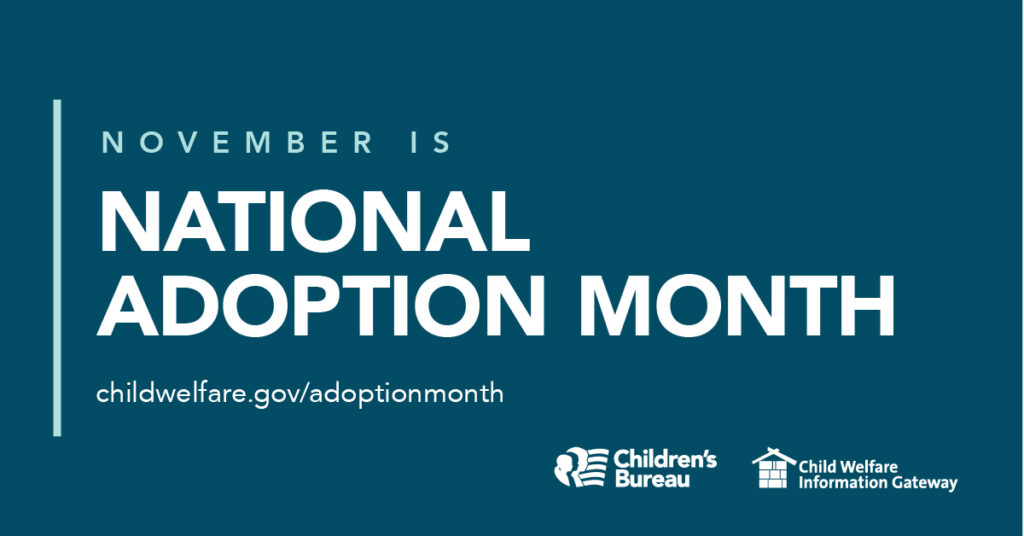When Love is Not Enough to Preserve a Forever Family for a Child

Families formed by adoption face unique challenges in their lifelong journey as adoptees, parents, and siblings. Adoption-competent mental health is a necessary resource for adoptive families. This November, we are honoring adoption as a vital permanency strategy and the importance of forever families in the lives of children and youth who need this sense of permanency, security, and wellbeing.
The Children’s Bureau, part of the U.S. Department of Health and Human Services Office of the Administration for Children and Families (ACF) created National Adoption month to increase national awareness of adoption issues, encourage the development of permanent relationships, and bring attention to the need for adoptive families to provide placement for teens in the U.S. foster care system. The theme for 2023, “Empowering Youth: Finding Points of Connection,” focuses on ways to provide opportunities and services that connect youth to their identity—including culture, background, interests, and ambitions – to support meaningful permanent relationships with adults.
Adoption Statistics
The following are key data from the fiscal year 2021 report for the Adoption and Foster Care Analysis and Reporting System.
In the U.S., as of September 30, 2021, there were 114,000 children and youth waiting to be adopted who were at risk of aging out of foster care without permanent family connections.
- More than one in five children waiting for adoption were 13–17 years old.
- The average age of all children waiting to be adopted was 7.5 years old.
- The average time in care for all children waiting to be adopted was 33.7 months.
- The average time in care for children waiting to be adopted after termination of parental rights was 19 months.
The National Council for Adoption reports an 18 percent decrease in adoptions from FY19-FY21, with over 19,000 children who aged out of foster care without a permanent family. There has been a 24 percent decrease in domestic adoptions from 2019-2020 and 93 percent decline in intercountry adoptions since peaking in 2004.[1] . These data points reflect the urgency of revitalizing adoption as an important tool for the wellbeing of children who need permanent loving families.
Recognizing that adoption is just the beginning of the family’s journey and the fact that adoptive families need special attention, especially when the children who have been adopted have suffered the trauma of entering the child welfare system, mental health treatment and resources are critical to the wellbeing of these families and the children in them.
Importance of Identity
Research has shown that strong cultural identity can contribute to mental health resilience, higher levels of social well-being, and improved coping skills, greater self-esteem, higher education levels, better psychological adjustment, and improved coping abilities.[2] But many youth in foster care often have lower cultural identity strength than those who did not experience foster care. This can lead to higher levels of loneliness and depression, lower self-esteem, and difficult psychological adjustments that in turn affect coping skills and learning.[3]
In her book You Should be Grateful, Angela Tucker offers many practical insights and tools aimed at nurturing identity and helping transracial families and adoptees to center around the cultural norms and experiences of the adoptees themselves.[4]
A Changing Landscape
Many states now have safe-haven laws where parents can drop off their babies without penalty at hospitals, fire stations or police department if they are not able to care for them knowing their babies will be cared for and placed in families through the child welfare system. At the same time there are many children and youth who languish in foster care waiting for a ‘forever family’ to adopt them. Thousands of teens in foster care are looking for the love, support, and encouragement that families provide throughout their lives—not just until they turn 18. Youth who were adopted from the foster care system when they are 16 or older may be able to access Education and Training Vouchers (ETV) of up to $5,000 per year. Those who were adopted from foster care when they are 13 or older are more likely to qualify for federal financial student aid because they do not have to count family income when applying.[5]
When it comes to medical and mental health benefits, qualifying families may receive federally funded monthly maintenance payments, and other support, often until a child turns 18 or 21, depending on the state where they live, and medical assistance until age 26 if they were in foster care at a certain age depending on the state. Recognizing the need for adoption competent mental health, the Federal Administration for Children and Families has awarded the Center for Adoption Support and Education the grant to build a national Center to Support Mental Health Services in the Child Welfare System.[6]
The recent Biden-Harris regulations strengthen services and supports for children and families in the child welfare system. These regulations require additional support for kinship families, and protections for LGBTQI+ youth and expansion of access to legal services for children and families entering the child welfare system. Congress could use the momentum from these regulations to make the Adoption Tax Credit fully refundable and extend it to legal guardians to assist with the financial resources of raising children.
The recent Supreme Court Dobbs decision will likely impact adoption trends, but that trend is still evolving and will need to be monitored before conclusions can be drawn.
How HMA Can Help
HMA assists organizations working in child welfare and adoption, and grounds our work in human-centered design, lived expertise, and change management and leadership principles in state and county program development. We can help support organizations working with children and youth in foster care or with adoption agencies by:
- Providing technical assistance to state and local government, and community-based organizations
- Developing system redesign and strategic planning
- Facilitating stakeholder engagement
- Implementing workforce and leadership development strategies
Visit the ACF website to learn more about National Adoption Month and find tools and resources to educate yourself and your community about how we can achieve better outcomes for youth in foster care.
If you have questions on how HMA can support your efforts in Child and Family Wellbeing, please contact:
Uma Ahluwalia, MSW, MHA, Managing Principal,
Jon Rubin, Principal, or
Caitlin Thomas-Henkel, Principal.
[1] Adoption by the Numbers – National Council for Adoption (adoptioncouncil.org)
[2] Anderson, M., & L.O. Linares. “The Role of Cultural Dissimilarity Factors on Child Adjustment Following Foster Placement.” Children and Youth Services Review 34(4), 2012, 597-601.
[3] Children on AdoptUSKids – AdoptUSKids
[4] “You Should Be Grateful” Stories of Race, Identity and Transracial Adoption — Angela Tucker

